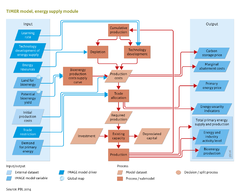Energy supply/Description: Difference between revisions
Jump to navigation
Jump to search
No edit summary |
No edit summary |
||
| Line 5: | Line 5: | ||
===Long-term depletion=== | ===Long-term depletion=== | ||
The depletion of fossil fuels (coal, oil and natural gas) and uranium is simulated on the basis of the assumption that their resources can be represented by a long-term supply cost curve, consisting of different resource categories with increasing costs levels. The model assumes that the cheapest deposits will be exploited first. For each region, there are 12 resource categories for oil, gas and nuclear fuels, and 14 categories for coal. | |||
A key input for each of the fossil-fuel and uranium supply submodels is that of fuel demand (i.e. fuel used in final energy and conversion processes). Additional input consists of conversion losses in refining, liquefaction, conversion, and energy use within the energy system. In the submodels, it is indicated how demand can be met by supply, both within a region and from other regions through interregional trade. | A key input for each of the fossil-fuel and uranium supply submodels is that of fuel demand (i.e. fuel used in final energy and conversion processes). Additional input consists of conversion losses in refining, liquefaction, conversion, and energy use within the energy system. In the submodels, it is indicated how demand can be met by supply, both within a region and from other regions through interregional trade. | ||
Revision as of 17:28, 10 December 2013
Parts of Energy supply/Description
| Component is implemented in: |
|
| Related IMAGE components |
| Projects/Applications |
| Key publications |
| References |
